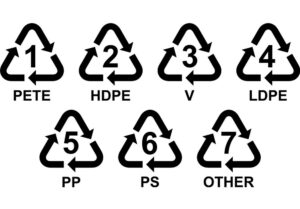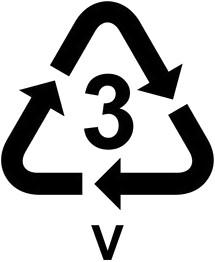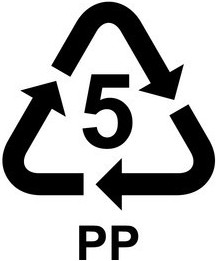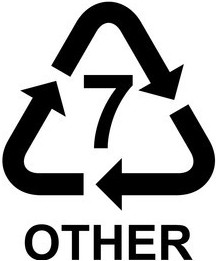Highlights
Recycling
Recycling logos

The series of recycling symbols on plastic items, a triangle with a number from 1 to 7 inside, can often tell you which kind of plastic the item is made of and how recyclable it is. The symbols, collectively called Resin Identification Code (RIC), were developed in 1988 by the organization now known as Plastics Industry Association. The symbols are currently administered by ASTM International, an organization that designs and sets standards for a wide range of industries and go by the official name ASTM International Resin Identification Coding System.
The symbols first included 3 bent arrows in the shape of a triangle. The solid triangles were introduced in 2013. The RIC system is helpful for both consumers and those who want to run plastics recycling operation, which generally deals with packaging used for consumer products.

This is the logo for polyethylene terephthalate, which is shortened to PET or PETE. This symbol is normally found on bottles for soft drinks and water, salad dressing, peanut butter, vegetable oil and mouthwash containers. PET can be recycled into new containers, pallet straps, paneling, carpet and clothing fibers. It can also be made into fiberfill for soft furnishing and sleeping bags.

This logo identifies high-density polyethylene or HDPE. This polymer is used to produce milk jugs, shampoo bottles, butter and yogurt tubs, motor oil bottle, bags inside cereal boxes, household cleaner, detergent bottles, etc. It can be recycled into pens, fencing, lumber, drainage pipes, picnic tables, floor tiles or various bottles or containers.

PVC, polyvinyl chloride or V for vinyl is identified as number 3. You can find PVC in piping, siding, medical equipment, clear food packaging, window cleaner / detergent and shampoo bottles. PVC is a polymer that is made into many different end use products as it can be rigid or flexible unlike most other polymers. PVC is rarely recycled. A tiny percentage of PVC is recycled into mats, cables, flooring mud flaps, paneling or speed bumps.

This polymer designated by a 4 in the recycling triangle is commonly used for food packaging such as bread, frozen products or used to make various type of bags. It is also used to make squeezable bottles, dry cleaning bags, furniture, etc. LDPE is rarely recycled. When it is recycled shipping envelopes, trash cans, bubble wraps and lumber are made from that resin.

A 5 inside the triangle indicates that the plastic is polypropylene or PP. It is often chosen to make bottles and containers that must accept hot liquids. Very versatile it can also be used for medicine bottles, yogurt containers, bottle caps, syrup or ketchup bottles. Thin films made of PP are used to package food products. Polypropylene is rarely recycled. When recycled trays, pallets, rakes, ice scrapers, brooms and brushes can be made.

This logo identifies polystyrene (PS). Too often people refer to foamed PS as Styrofoam erroneously. Styrofoam is the name of a Dow-trademarked brand of insulation board made of foamed PS. Polystyrene is used to make toys, meat trays, cups, plates, cutlery and carry-out containers. Still to this day the light weight foamed PS is present in the food industry for hot food take out. This polymer is not often recycled as it has been banned by many municipalities as the most recognizable form is foam packaging that is light weight, bulky. It is possible to recycle PS in insulation board, light switch plates, office supplies.

Any plastic that does not fall under the one of those six types has a 7 inside the triangle. These plastics include nylon, acrylic, polycarbonate, are found in some food container, signs, cosmetic packaging, electronic devises, DVDs, sunglasses. These plastics are almost never recycled, but they can be recycled into custom-made products. Sadly, the flexible packaging industry has been using this recycling on bags made of different layers of plastic films. Such bags are not recyclable.
Q & A
Are plastic jars recyclable?
Plastic jars are manufactured using different type of polymers. The most common plastic used are PET, PP and HDPE. All three (3) polymers are recyclable and are being recycled. The most recycled polymers are PET and HDPE. PP is often not segregated like PET and HDPE are.
How should I dispose of plastic jars?
The jar should be separated from the cap, then the liner should be put in the waste basket as it is not recyclable. Finally, if possible, the label should be removed from the jar.
Why are colored jars used to packaging cannabis products?
As per Health Canada’s legislation all packaging products have to be opaque so the product inside is not visible. This is why all Cannabis packaging products are colored. The only exception is for “wrappers” that are secured to a CR device.
Are colored jars recyclable?
Yes colored jars are recyclable. But because there are many different type of sorting facilities, it is possible that on a local basis some types or polymers or colored polymers may not be recycled.
Are zipper bags recyclable?
The zipper bags made used to package dry cannabis flowers are not recyclable as they are made of at least 3 layers of different plastic.
Why is there a liner glued to the jar?
The liner glued to the jar is there to keep the product’s freshness by closing the jars opening hermetically. Note that the liner is not recyclable.
